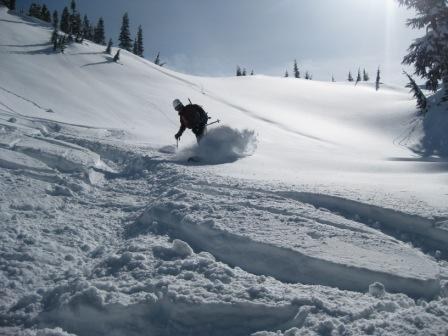
Ten years ago the Forest Service issued a travel management rule designated to regulate wheeled vehicle use on Forest lands. At the time, snowmobiles were considered “optional” to regulate, and were therefore not included in the legislation. Then, last summer, we asked you to share your voice on a new proposal for winter travel management in our National Forests. Now, a new regulation known as the Over Snow Vehicle Travel Rule has been passed to account for snowmobile use.
Under the new policy, National Forests must designate specific areas for snowmobile use AND publish these areas on an over-snow vehicle (OSV) use map. These maps clearly show roads and trails where snowmobiles are allowed. Any use of snowmobiles outside those published areas will be prohibited. The forest service should have some maps ready for this 2015-2016 winter season, but many forests will need to go through the process of designating snowmobile routes and areas before they can publish a map.
Here's the full update on the National Forest's ruling on motorized winter use. Provided by Hilary Eisen and our Outdoor Alliance partners at Winter Wildlands Alliance.
The Long Awaited Winter Planning Rule is Out, What’s Next?
The result of a decade-long initiative by Winter Wildlands Alliance and our constituents, the new Over-Snow Vehicle Rule (OSV Rule) was released January 27, 2015 and became law 30 days later. Thanks to the unprecedented number and quality of public comments from the backcountry community, the final Rule is a significant improvement over the draft rule, which was released for public comment in June 2014.
Now that the Rule is in place it’s time to move on to the nuts and bolts of winter travel planning, and what comes next depends on how much individual forests have done to “zone” trails and areas for motorized and human-powered recreation in the past.
Forests that already have acceptable regulations in place will simply need to provide public notice that they will be moving forward with existing management and print Over-Snow Vehicle Use Maps in order to comply with the new rule. The Forest Service has indicated that we should see maps by next winter for those National Forests that are already in compliance. Forests that do not have winter travel plans will need to determine specific routes and areas that will be open to snowmobiles, with all other routes and areas not specifically designated open being closed, and then publish these designations on a map. This winter travel management planning process is subject to the National Environmental Protection Act and thus there will be several opportunities for the public to weigh in with comments as the plans are developed.
All in all, winter travel planning on any given forest will likely take 2-3 years from start to finish. The Forest Service has not set a timeline for when specific forests must complete these travel plans, and is still in the process of determining what sorts of decisions are already on the books. WWA, along with our grassroots partners, will continue to communicate our priorities locally, regionally, and nationally about where winter travel planning is critical to improve the backcountry experience and resolve longstanding issues.
The first forests in the country to tackle winter travel planning under the new rule are all located in California. The Lassen, Tahoe, Eldorado, Stanislaus, and Plumas National Forests are just starting this process. In early 2015 the Lassen released their Proposed Action (a starting point for travel planning) and solicited scoping comments from the public. The Tahoe and Eldorado have also begun this phase with the Stanislaus and Plumas to follow. At the scoping stage the Forest Service is looking for input on what elements should be included in the new plan and what issues to consider as they develop Alternatives. The next step is for the Forest Service to develop Alternative management scenarios and then analyze and compare these Alternatives to determine which Alternative, or combination of Alternatives, should become the final travel plan. This is the same basic process will be replicated across the country, and we are working with our local partner group, Snowlands Network, to ensure these forests set a good precedent.
Through winter travel planning Winter Wildlands Alliance and our members will advocate to protect sensitive winter wildlands and areas that are important for human-powered recreation. The Mountaineers looks forward to working with Winter Wildlands Alliance through implementation of the OSV Rule with all stakeholders. This is the time for all of us who enjoy human-powered activities such as backcountry and Nordic skiing, snowboarding, snowshoeing, and winter mountaineering to speak up for the places, and experiences, we value. If you would like to learn more about travel planning on a specific National Forest please contact WWA’s Recreation Planning Coordinator, Hilary Eisen, at heisen@winterwildlands.org or Katherine Hollis, Conservation and Recreation Manager, at katherineh@mountaineers.org.
 Katherine Hollis
Katherine Hollis